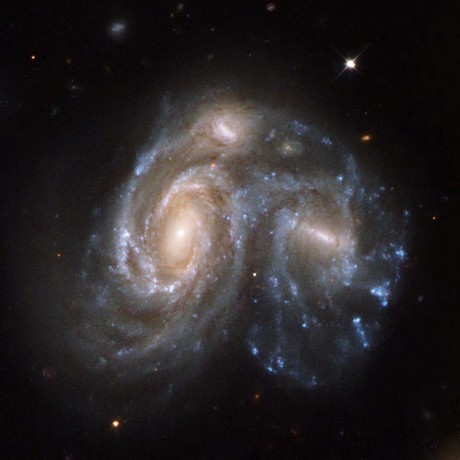Galaxies get fat as they age

Much like people, galaxies fall victim to the middle-aged spread as they get older, becoming less elliptical and more round, according to Australian and US scientists.
Determining a galaxy’s shape is fiddly, because we can only see them in two dimensions, but the researchers used complex data from the Anglo–Australian Telescope at Siding Spring Observatory in Australia to determine the ages and shapes of 722 galaxies.
An international study involving The Australian National University (ANU) and The University of Sydney has found a strong correlation between the age of a galaxy and how round it is. The researchers studied 843 galaxies of all kinds and with a hundred-fold range in mass. The findings have been published in Nature Astronomy.
Co-researcher Professor Matthew Colless from ANU said that stars in a young galaxy moved in an orderly way around the galaxy’s disk, much like cars around a racetrack.
“All galaxies look like squashed spheres, but as they grow older they become puffier with stars going around in all directions,” said Professor Colless, Director of the ANU Research School of Astronomy and Astrophysics and Chief Investigator at the ARC Centre of Excellence for All-sky Astrophysics in 3D (ASTRO 3D).
“Our Milky Way is more than 13 billion years old, so it is not young anymore, but the galaxy still has both a central bulge of old stars and spiral arms of young stars.”
To work out a galaxy’s shape, the research team measured the movement of stars with an instrument called SAMI on the Anglo-Australian Telescope at the ANU Siding Spring Observatory.
Lead author Dr Jesse van de Sande, from The University of Sydney and ASTRO 3D, said that it was not obvious that galaxy shape and age had to be linked, so the connection was surprising and could point to a deep underlying relationship.
“As a galaxy ages, internal changes take place and the galaxy may collide with others,” Dr van de Sande said.
“These events disorder the stars’ movements.”
Co-author Dr Nicholas Scott, from the University of Sydney and ASTRO 3D, said scientists measured a galaxy’s age through colour.
“Young, blue stars grow old and turn red,” he said.
“When we plotted how ordered the galaxies were against how squashed they were, the relationship with age leapt out. Galaxies that have the same squashed spherical shape have stars of the same age as well.”
Dr van de Sande said scientists had known for a long time that shape and age were linked in very extreme galaxies — that is very flat ones and very round ones.
“This is the first time we’ve shown shape and age are related for all kinds of galaxies, not just the extremes — all shapes, all ages, all masses,” he said.
University of Sydney co-author Dr Julia Bryant, lead scientist for the SAMI instrument, said the team was still searching for the simple, powerful relationships like shape and age that underlie a lot of the complexity scientists see in galaxies.
“To see those relationships, you need detailed information on large numbers of galaxies,” she said.
The Anglo-Australian Observatory (AAO) is building SAMI’s successor instrument, Hector, which is designed to observe 100 galaxies at a time.
The study, involving the University of Sydney, The University of New South Wales, ANU, International Centre for Radio Astronomy Research (ICRAR) and Macquarie University, was funded by ASTRO 3D at ANU and the ARC Centre of Excellence for All-Sky Astrophysics (CAASTRO) at The University of Sydney.
Colon cancer DNA in blood can guide chemo decisions
A simple blood test could change how doctors decide which patients with colon cancer need...
Non-invasive blood test helps rule out oesophageal cancer
Designed and developed in Australia, the PromarkerEso test is designed to offer a quick,...
Taste-based flu test enables rapid diagnosis
The diagnostic tool consists of the sensor molecule thymol and a virus-specific sugar building...





